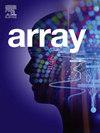An attention based residual U-Net with swin transformer for brain MRI segmentation
IF 2.3
Q2 COMPUTER SCIENCE, THEORY & METHODS
引用次数: 0
Abstract
Brain Tumors are a life-threatening cancer type. Due to the varied types and aggressive nature of these tumors, medical diagnostics faces significant challenges. Effective diagnosis and treatment planning depends on identifying the brain tumor areas from MRI images accurately. Traditional methods tend to use manual segmentation, which is costly, time consuming and prone to errors. Automated segmentation using deep learning approaches has shown potential in detecting tumor region. However, the complexity of the tumor areas which contain various shapes, sizes, fuzzy boundaries, makes this process difficult. Therefore, a robust automated segmentation method in brain tumor segmentation is required. In our paper, we present a hybrid model, 3-Dimension (3D) ResAttU-Net-Swin, which combines residual U-Net, attention mechanism and swin transformer. Residual blocks are introduced in the U-Net structure as encoder and decoder to avoid vanishing gradient problems and improve feature recovery. Attention-based skip connections are used to enhance the feature information transition between the encoder and decoder. The swin transformer obtains broad-scale features from the image data. The proposed hybrid model was evaluated on both the BraTS 2020 and BraTS 2019 datasets. It achieved an average Dice Similarity Coefficients (DSC) of 88.27 % and average Intersection over Union (IoU) of 79.93 % on BraTS 2020. On BraTS 2019, the model achieved an average DSC of 89.20 % and average IoU of 81.40 %. The model obtains higher DSC than the existing methods. The experiment result shows that the proposed methodology, 3D ResAttU-Net-Swin can be a potential for brain tumor segmentation in clinical settings.
基于swin变压器的残差U-Net脑MRI分割
脑瘤是一种危及生命的癌症。由于这些肿瘤的不同类型和侵袭性,医学诊断面临重大挑战。有效的诊断和治疗方案取决于从MRI图像中准确识别脑肿瘤区域。传统方法多采用人工分割,成本高、耗时长、易出错。使用深度学习方法的自动分割在检测肿瘤区域方面显示出潜力。然而,肿瘤区域的复杂性,包括各种形状,大小,模糊的边界,使这一过程变得困难。因此,在脑肿瘤分割中需要一种鲁棒的自动分割方法。在本文中,我们提出了一个混合模型,三维(3D) ResAttU-Net-Swin,它结合了残差U-Net、注意机制和swin变压器。在U-Net结构中引入残差块作为编码器和解码器,避免了梯度消失问题,提高了特征恢复能力。基于注意的跳变连接用于增强编码器和解码器之间的特征信息转换。旋转变压器从图像数据中获得宽尺度特征。在BraTS 2020和BraTS 2019数据集上对所提出的混合模型进行了评估。在BraTS 2020上,它实现了平均骰子相似系数(DSC)为88.27%,平均交集比联合(IoU)为79.93%。在BraTS 2019上,该模型的平均DSC为89.20%,平均IoU为81.40%。该模型获得了比现有方法更高的DSC。实验结果表明,所提出的3D ResAttU-Net-Swin方法在临床环境中具有潜在的脑肿瘤分割潜力。
本文章由计算机程序翻译,如有差异,请以英文原文为准。
求助全文
约1分钟内获得全文
求助全文

 求助内容:
求助内容: 应助结果提醒方式:
应助结果提醒方式:


